Analysis of Human Resource Management in Placenta: Report
VerifiedAdded on 2021/01/02
|6
|1315
|258
Report
AI Summary
This report provides a comprehensive analysis of human resource management practices at Placenta. It begins by examining the organisational structure, differentiating between tall and flat structures and their implications for employee motivation and communication. The report then delves into Placenta's corporate culture, utilizing Charles Handy's model to explore power, role, task, and person cultures and their influence on recruited employees. Furthermore, the study investigates various management styles, including autocratic, democratic, and laissez-faire approaches, assessing their impact on employee training and development. The conclusion summarizes the findings, emphasizing the significant effects of organisational structure and culture on employee motivation and the importance of democratic management styles in fostering a positive work environment. The report draws on several academic sources to support its analysis.
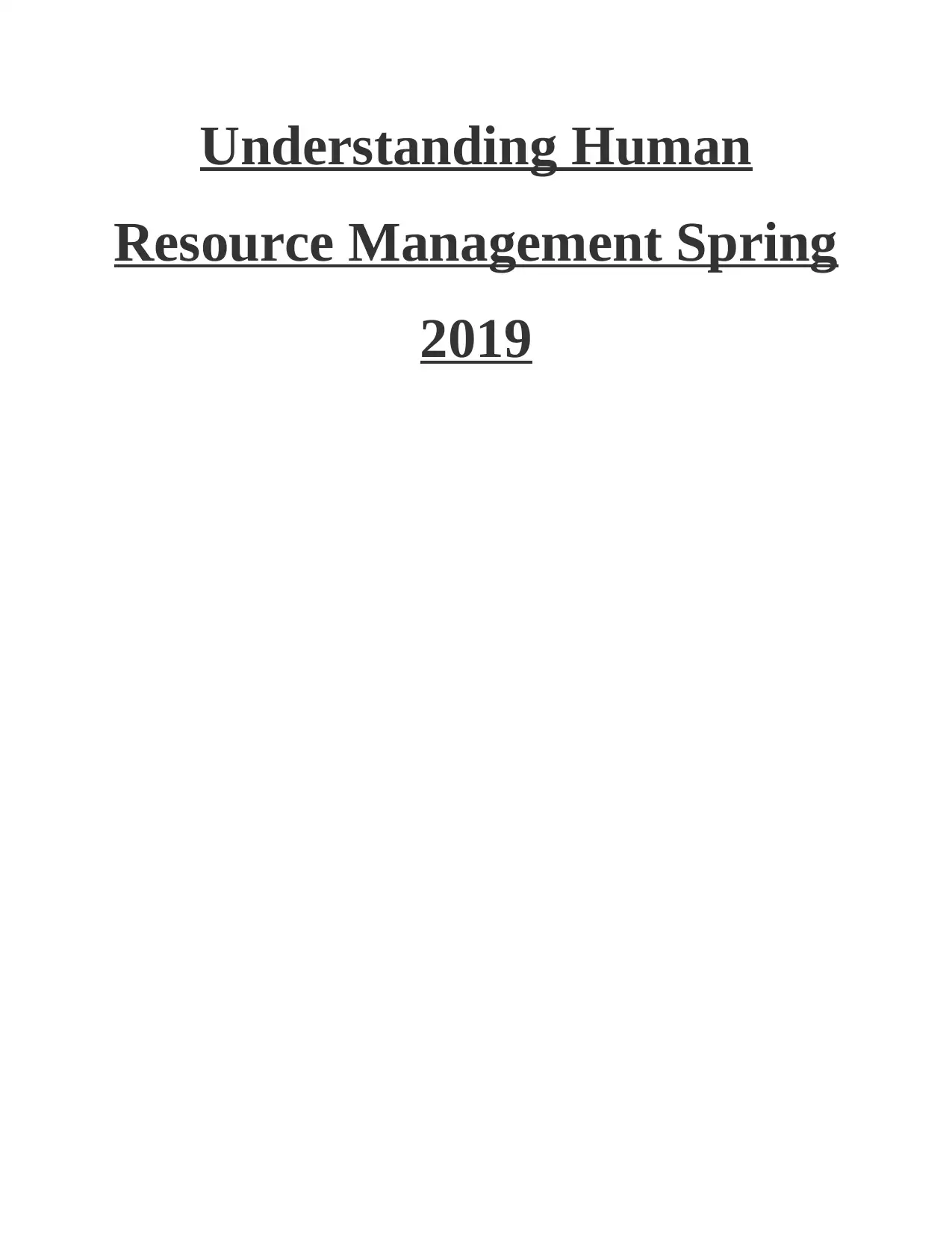
Understanding Human
Resource Management Spring
2019
Resource Management Spring
2019
Paraphrase This Document
Need a fresh take? Get an instant paraphrase of this document with our AI Paraphraser
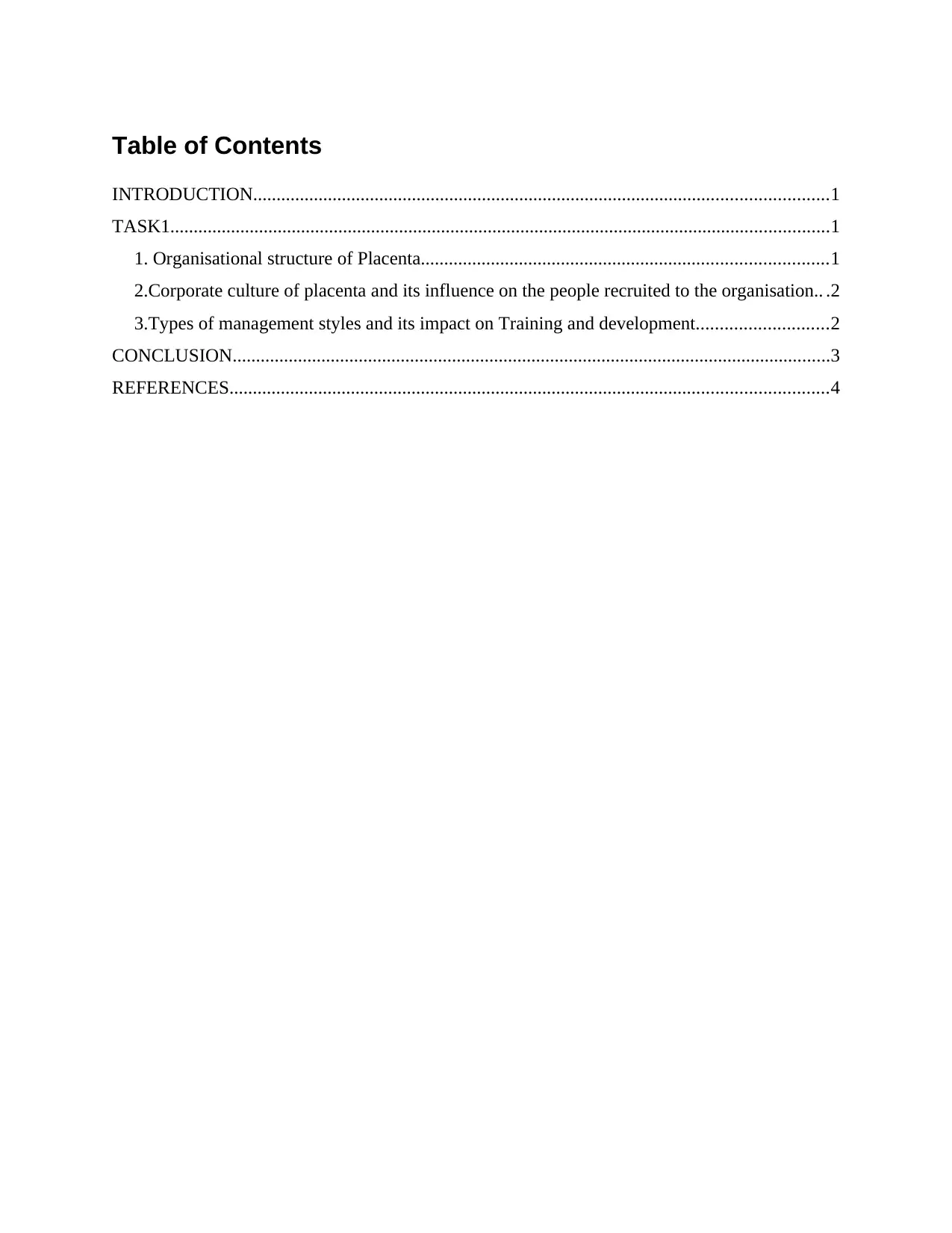
Table of Contents
INTRODUCTION...........................................................................................................................1
TASK1.............................................................................................................................................1
1. Organisational structure of Placenta.......................................................................................1
2.Corporate culture of placenta and its influence on the people recruited to the organisation.. .2
3.Types of management styles and its impact on Training and development............................2
CONCLUSION................................................................................................................................3
REFERENCES................................................................................................................................4
INTRODUCTION...........................................................................................................................1
TASK1.............................................................................................................................................1
1. Organisational structure of Placenta.......................................................................................1
2.Corporate culture of placenta and its influence on the people recruited to the organisation.. .2
3.Types of management styles and its impact on Training and development............................2
CONCLUSION................................................................................................................................3
REFERENCES................................................................................................................................4
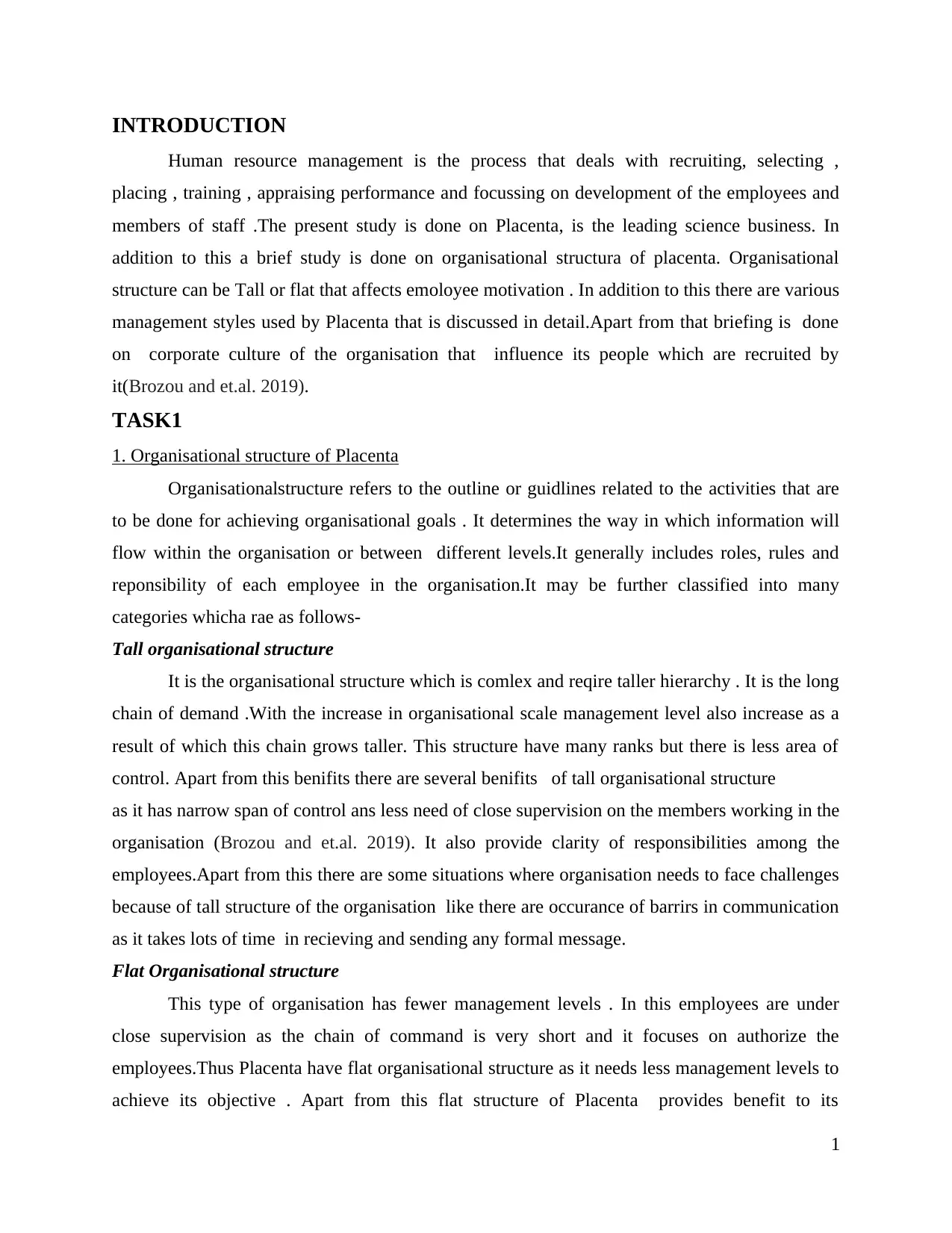
INTRODUCTION
Human resource management is the process that deals with recruiting, selecting ,
placing , training , appraising performance and focussing on development of the employees and
members of staff .The present study is done on Placenta, is the leading science business. In
addition to this a brief study is done on organisational structura of placenta. Organisational
structure can be Tall or flat that affects emoloyee motivation . In addition to this there are various
management styles used by Placenta that is discussed in detail.Apart from that briefing is done
on corporate culture of the organisation that influence its people which are recruited by
it(Brozou and et.al. 2019).
TASK1
1. Organisational structure of Placenta
Organisationalstructure refers to the outline or guidlines related to the activities that are
to be done for achieving organisational goals . It determines the way in which information will
flow within the organisation or between different levels.It generally includes roles, rules and
reponsibility of each employee in the organisation.It may be further classified into many
categories whicha rae as follows-
Tall organisational structure
It is the organisational structure which is comlex and reqire taller hierarchy . It is the long
chain of demand .With the increase in organisational scale management level also increase as a
result of which this chain grows taller. This structure have many ranks but there is less area of
control. Apart from this benifits there are several benifits of tall organisational structure
as it has narrow span of control ans less need of close supervision on the members working in the
organisation (Brozou and et.al. 2019). It also provide clarity of responsibilities among the
employees.Apart from this there are some situations where organisation needs to face challenges
because of tall structure of the organisation like there are occurance of barrirs in communication
as it takes lots of time in recieving and sending any formal message.
Flat Organisational structure
This type of organisation has fewer management levels . In this employees are under
close supervision as the chain of command is very short and it focuses on authorize the
employees.Thus Placenta have flat organisational structure as it needs less management levels to
achieve its objective . Apart from this flat structure of Placenta provides benefit to its
1
Human resource management is the process that deals with recruiting, selecting ,
placing , training , appraising performance and focussing on development of the employees and
members of staff .The present study is done on Placenta, is the leading science business. In
addition to this a brief study is done on organisational structura of placenta. Organisational
structure can be Tall or flat that affects emoloyee motivation . In addition to this there are various
management styles used by Placenta that is discussed in detail.Apart from that briefing is done
on corporate culture of the organisation that influence its people which are recruited by
it(Brozou and et.al. 2019).
TASK1
1. Organisational structure of Placenta
Organisationalstructure refers to the outline or guidlines related to the activities that are
to be done for achieving organisational goals . It determines the way in which information will
flow within the organisation or between different levels.It generally includes roles, rules and
reponsibility of each employee in the organisation.It may be further classified into many
categories whicha rae as follows-
Tall organisational structure
It is the organisational structure which is comlex and reqire taller hierarchy . It is the long
chain of demand .With the increase in organisational scale management level also increase as a
result of which this chain grows taller. This structure have many ranks but there is less area of
control. Apart from this benifits there are several benifits of tall organisational structure
as it has narrow span of control ans less need of close supervision on the members working in the
organisation (Brozou and et.al. 2019). It also provide clarity of responsibilities among the
employees.Apart from this there are some situations where organisation needs to face challenges
because of tall structure of the organisation like there are occurance of barrirs in communication
as it takes lots of time in recieving and sending any formal message.
Flat Organisational structure
This type of organisation has fewer management levels . In this employees are under
close supervision as the chain of command is very short and it focuses on authorize the
employees.Thus Placenta have flat organisational structure as it needs less management levels to
achieve its objective . Apart from this flat structure of Placenta provides benefit to its
1
⊘ This is a preview!⊘
Do you want full access?
Subscribe today to unlock all pages.

Trusted by 1+ million students worldwide
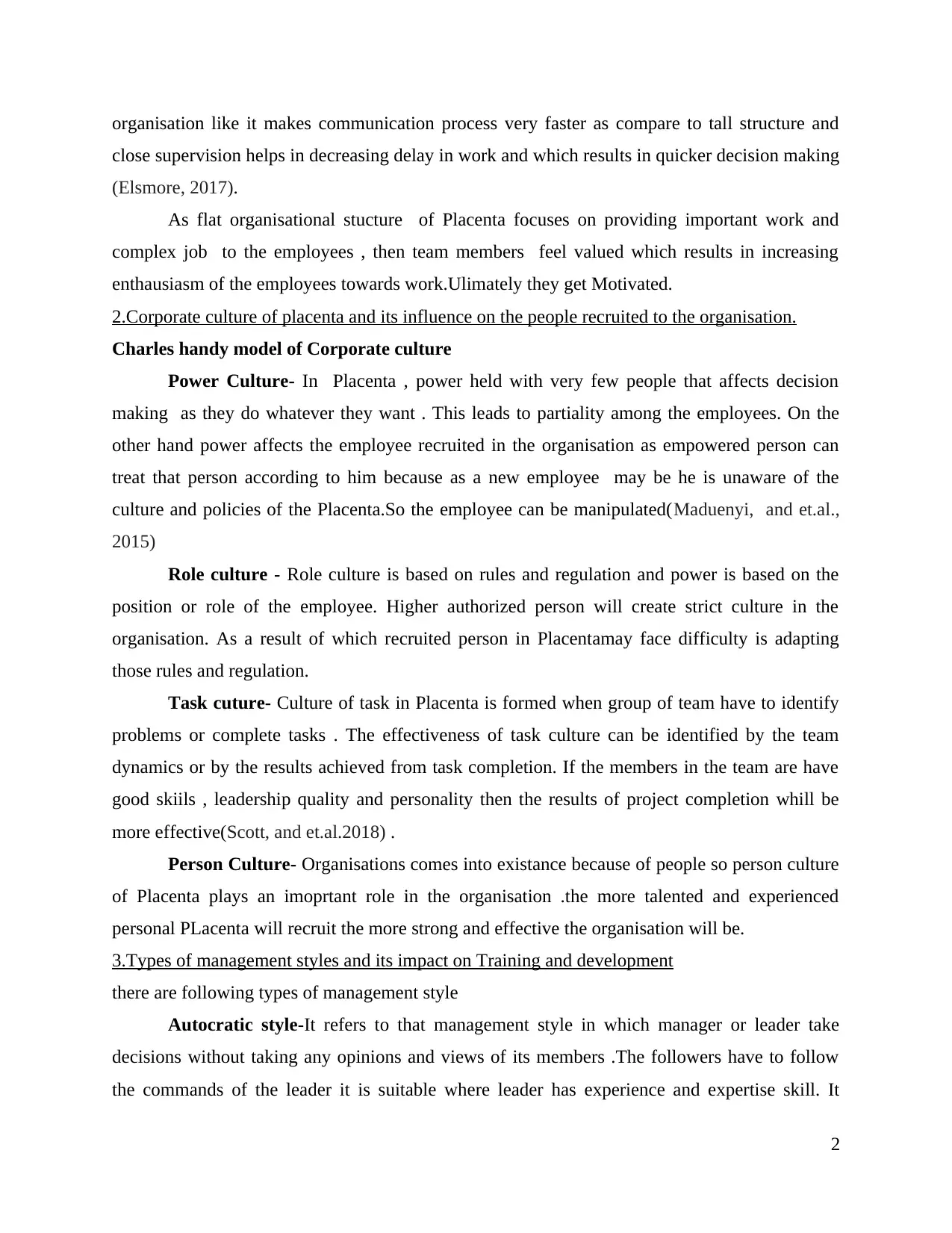
organisation like it makes communication process very faster as compare to tall structure and
close supervision helps in decreasing delay in work and which results in quicker decision making
(Elsmore, 2017).
As flat organisational stucture of Placenta focuses on providing important work and
complex job to the employees , then team members feel valued which results in increasing
enthausiasm of the employees towards work.Ulimately they get Motivated.
2.Corporate culture of placenta and its influence on the people recruited to the organisation.
Charles handy model of Corporate culture
Power Culture- In Placenta , power held with very few people that affects decision
making as they do whatever they want . This leads to partiality among the employees. On the
other hand power affects the employee recruited in the organisation as empowered person can
treat that person according to him because as a new employee may be he is unaware of the
culture and policies of the Placenta.So the employee can be manipulated(Maduenyi, and et.al.,
2015)
Role culture - Role culture is based on rules and regulation and power is based on the
position or role of the employee. Higher authorized person will create strict culture in the
organisation. As a result of which recruited person in Placentamay face difficulty is adapting
those rules and regulation.
Task cuture- Culture of task in Placenta is formed when group of team have to identify
problems or complete tasks . The effectiveness of task culture can be identified by the team
dynamics or by the results achieved from task completion. If the members in the team are have
good skiils , leadership quality and personality then the results of project completion whill be
more effective(Scott, and et.al.2018) .
Person Culture- Organisations comes into existance because of people so person culture
of Placenta plays an imoprtant role in the organisation .the more talented and experienced
personal PLacenta will recruit the more strong and effective the organisation will be.
3.Types of management styles and its impact on Training and development
there are following types of management style
Autocratic style-It refers to that management style in which manager or leader take
decisions without taking any opinions and views of its members .The followers have to follow
the commands of the leader it is suitable where leader has experience and expertise skill. It
2
close supervision helps in decreasing delay in work and which results in quicker decision making
(Elsmore, 2017).
As flat organisational stucture of Placenta focuses on providing important work and
complex job to the employees , then team members feel valued which results in increasing
enthausiasm of the employees towards work.Ulimately they get Motivated.
2.Corporate culture of placenta and its influence on the people recruited to the organisation.
Charles handy model of Corporate culture
Power Culture- In Placenta , power held with very few people that affects decision
making as they do whatever they want . This leads to partiality among the employees. On the
other hand power affects the employee recruited in the organisation as empowered person can
treat that person according to him because as a new employee may be he is unaware of the
culture and policies of the Placenta.So the employee can be manipulated(Maduenyi, and et.al.,
2015)
Role culture - Role culture is based on rules and regulation and power is based on the
position or role of the employee. Higher authorized person will create strict culture in the
organisation. As a result of which recruited person in Placentamay face difficulty is adapting
those rules and regulation.
Task cuture- Culture of task in Placenta is formed when group of team have to identify
problems or complete tasks . The effectiveness of task culture can be identified by the team
dynamics or by the results achieved from task completion. If the members in the team are have
good skiils , leadership quality and personality then the results of project completion whill be
more effective(Scott, and et.al.2018) .
Person Culture- Organisations comes into existance because of people so person culture
of Placenta plays an imoprtant role in the organisation .the more talented and experienced
personal PLacenta will recruit the more strong and effective the organisation will be.
3.Types of management styles and its impact on Training and development
there are following types of management style
Autocratic style-It refers to that management style in which manager or leader take
decisions without taking any opinions and views of its members .The followers have to follow
the commands of the leader it is suitable where leader has experience and expertise skill. It
2
Paraphrase This Document
Need a fresh take? Get an instant paraphrase of this document with our AI Paraphraser
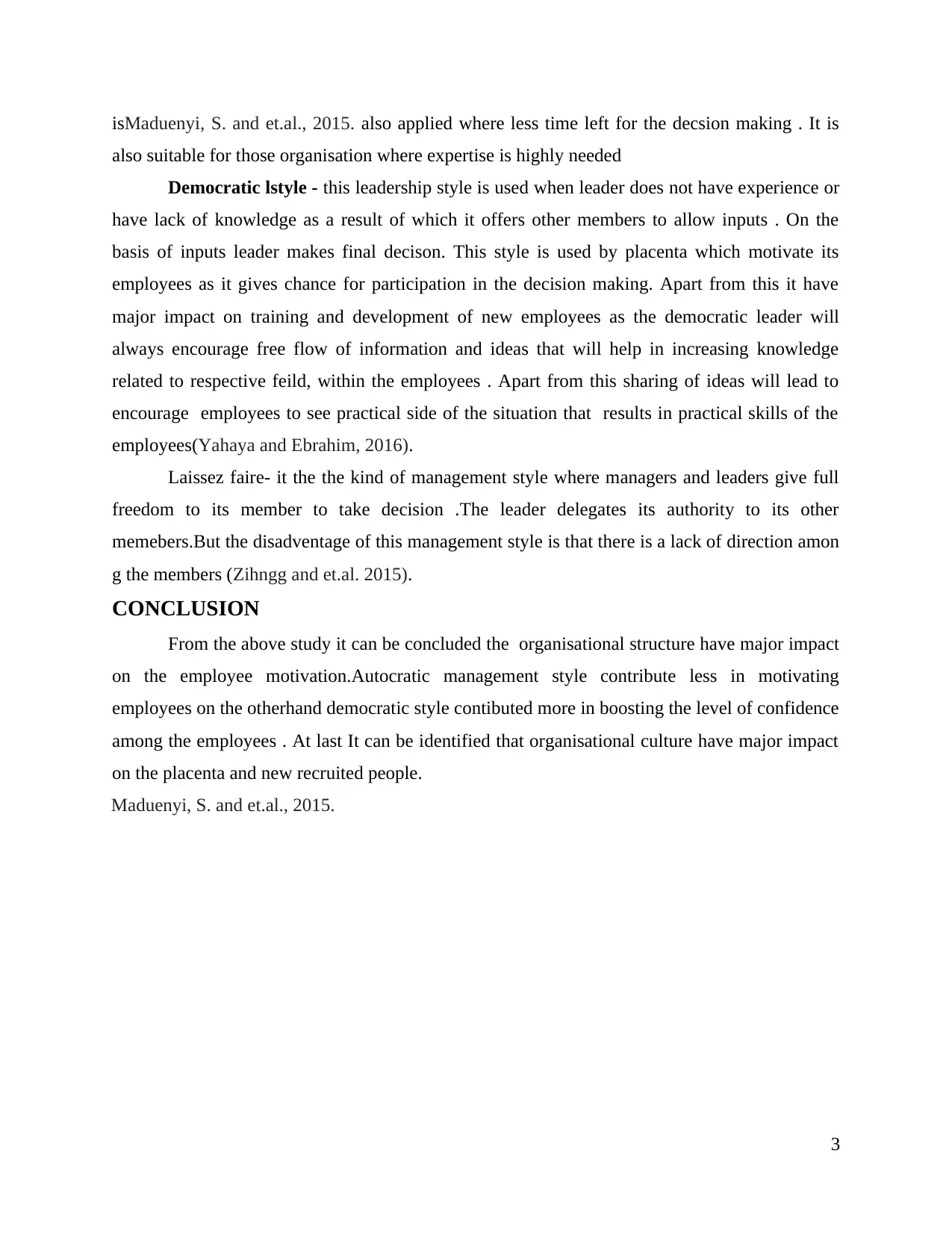
isMaduenyi, S. and et.al., 2015. also applied where less time left for the decsion making . It is
also suitable for those organisation where expertise is highly needed
Democratic lstyle - this leadership style is used when leader does not have experience or
have lack of knowledge as a result of which it offers other members to allow inputs . On the
basis of inputs leader makes final decison. This style is used by placenta which motivate its
employees as it gives chance for participation in the decision making. Apart from this it have
major impact on training and development of new employees as the democratic leader will
always encourage free flow of information and ideas that will help in increasing knowledge
related to respective feild, within the employees . Apart from this sharing of ideas will lead to
encourage employees to see practical side of the situation that results in practical skills of the
employees(Yahaya and Ebrahim, 2016).
Laissez faire- it the the kind of management style where managers and leaders give full
freedom to its member to take decision .The leader delegates its authority to its other
memebers.But the disadventage of this management style is that there is a lack of direction amon
g the members (Zihngg and et.al. 2015).
CONCLUSION
From the above study it can be concluded the organisational structure have major impact
on the employee motivation.Autocratic management style contribute less in motivating
employees on the otherhand democratic style contibuted more in boosting the level of confidence
among the employees . At last It can be identified that organisational culture have major impact
on the placenta and new recruited people.
Maduenyi, S. and et.al., 2015.
3
also suitable for those organisation where expertise is highly needed
Democratic lstyle - this leadership style is used when leader does not have experience or
have lack of knowledge as a result of which it offers other members to allow inputs . On the
basis of inputs leader makes final decison. This style is used by placenta which motivate its
employees as it gives chance for participation in the decision making. Apart from this it have
major impact on training and development of new employees as the democratic leader will
always encourage free flow of information and ideas that will help in increasing knowledge
related to respective feild, within the employees . Apart from this sharing of ideas will lead to
encourage employees to see practical side of the situation that results in practical skills of the
employees(Yahaya and Ebrahim, 2016).
Laissez faire- it the the kind of management style where managers and leaders give full
freedom to its member to take decision .The leader delegates its authority to its other
memebers.But the disadventage of this management style is that there is a lack of direction amon
g the members (Zihngg and et.al. 2015).
CONCLUSION
From the above study it can be concluded the organisational structure have major impact
on the employee motivation.Autocratic management style contribute less in motivating
employees on the otherhand democratic style contibuted more in boosting the level of confidence
among the employees . At last It can be identified that organisational culture have major impact
on the placenta and new recruited people.
Maduenyi, S. and et.al., 2015.
3
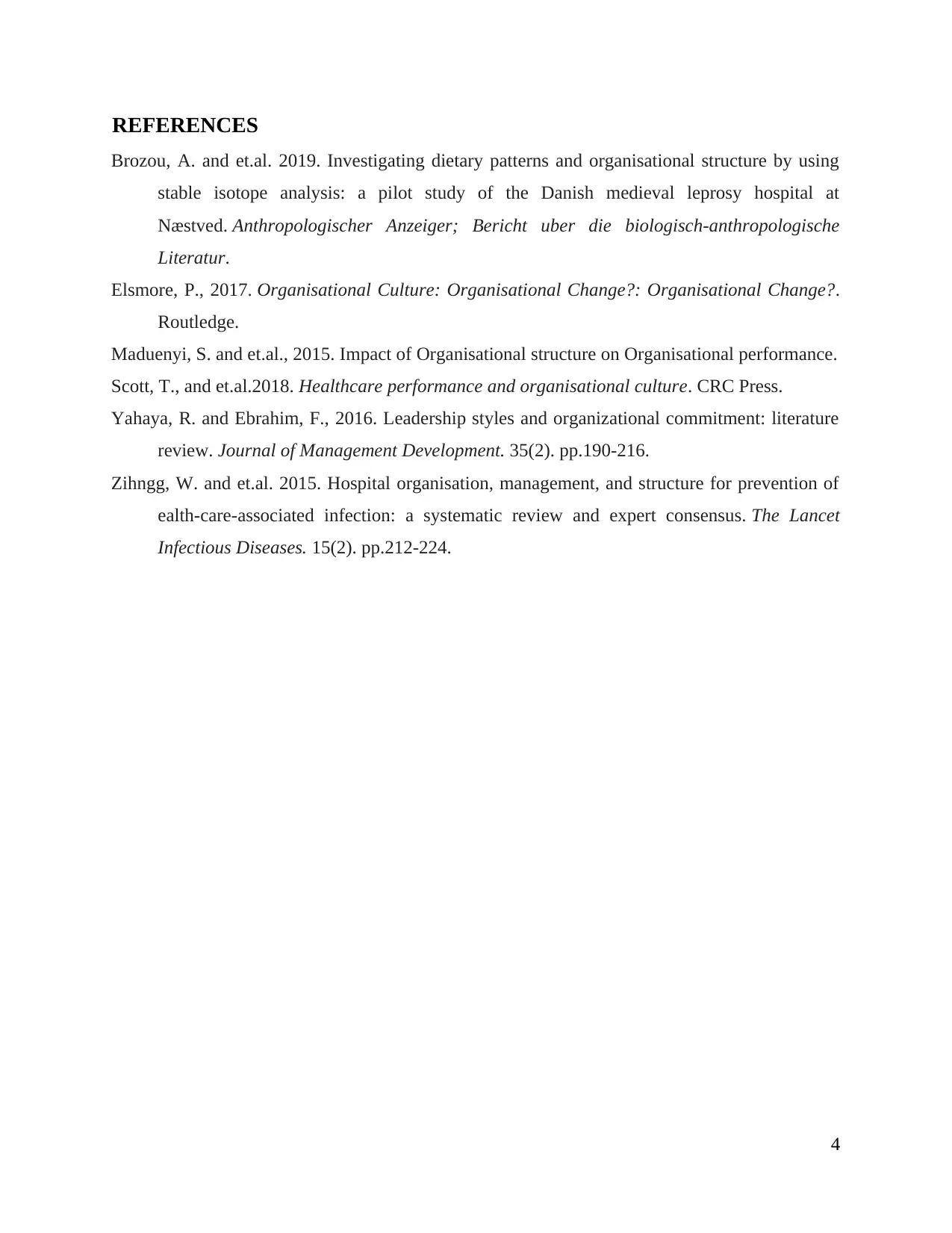
REFERENCES
Brozou, A. and et.al. 2019. Investigating dietary patterns and organisational structure by using
stable isotope analysis: a pilot study of the Danish medieval leprosy hospital at
Næstved. Anthropologischer Anzeiger; Bericht uber die biologisch-anthropologische
Literatur.
Elsmore, P., 2017. Organisational Culture: Organisational Change?: Organisational Change?.
Routledge.
Maduenyi, S. and et.al., 2015. Impact of Organisational structure on Organisational performance.
Scott, T., and et.al.2018. Healthcare performance and organisational culture. CRC Press.
Yahaya, R. and Ebrahim, F., 2016. Leadership styles and organizational commitment: literature
review. Journal of Management Development. 35(2). pp.190-216.
Zihngg, W. and et.al. 2015. Hospital organisation, management, and structure for prevention of
ealth-care-associated infection: a systematic review and expert consensus. The Lancet
Infectious Diseases. 15(2). pp.212-224.
4
Brozou, A. and et.al. 2019. Investigating dietary patterns and organisational structure by using
stable isotope analysis: a pilot study of the Danish medieval leprosy hospital at
Næstved. Anthropologischer Anzeiger; Bericht uber die biologisch-anthropologische
Literatur.
Elsmore, P., 2017. Organisational Culture: Organisational Change?: Organisational Change?.
Routledge.
Maduenyi, S. and et.al., 2015. Impact of Organisational structure on Organisational performance.
Scott, T., and et.al.2018. Healthcare performance and organisational culture. CRC Press.
Yahaya, R. and Ebrahim, F., 2016. Leadership styles and organizational commitment: literature
review. Journal of Management Development. 35(2). pp.190-216.
Zihngg, W. and et.al. 2015. Hospital organisation, management, and structure for prevention of
ealth-care-associated infection: a systematic review and expert consensus. The Lancet
Infectious Diseases. 15(2). pp.212-224.
4
⊘ This is a preview!⊘
Do you want full access?
Subscribe today to unlock all pages.

Trusted by 1+ million students worldwide
1 out of 6
Related Documents
Your All-in-One AI-Powered Toolkit for Academic Success.
+13062052269
info@desklib.com
Available 24*7 on WhatsApp / Email
![[object Object]](/_next/static/media/star-bottom.7253800d.svg)
Unlock your academic potential
Copyright © 2020–2025 A2Z Services. All Rights Reserved. Developed and managed by ZUCOL.





